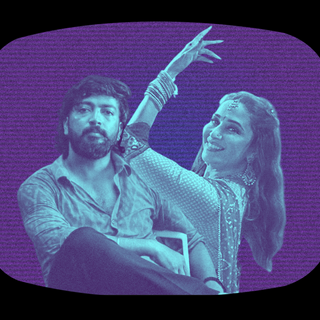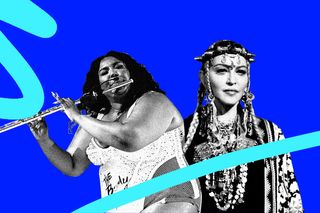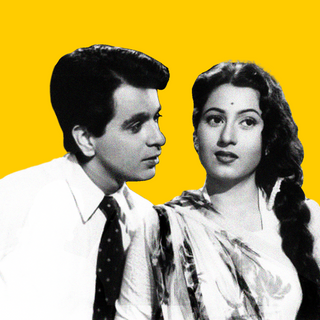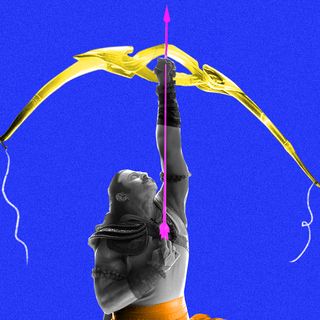
Why Fixating on Women’s Bodies Hurts the Legacy of Art
After Lizzo’s body was the subject of conversation as she played James Madison’s flute, Madonna’s face is the newest topic of discussion. It undermines the existence of women in the canon of art.

It happened with Marilyn Monroe (as the infamous film Blonde tries to remind us), and it’s happening still, decades later. Women who create great art are constantly undercut by the public’s gaze on their bodies.
It’s a paradox because we ostensibly live in a world where women have fewer institutional barriers to creating art than they did before. But such is the wily hand of patriarchy that where some barriers are knocked down, others are erected. In the context of our times, it’s in the form of a vivisecting gaze that shifts the focus away from the art that women create, and onto their bodies. In other words, beauty is a prerequisite for women creating art, and it hurts the legacy they leave behind.
When Lizzo played U.S. President James Madison’s flute, she was subject to intense body shaming and humiliation online. In Lizzo’s Black, Female, and Fat Resistance, scholars Niya Pickett Miller and Gheni N. Platenburg note “Lizzo’s Black, fat, and female flaunting is posited as a kind of visibility politics because her beingness expands the (typically negative) visual trope of large Black women in American popular culture.” When she played Madison’s flute and twerked with it, she resisted centuries of oppressive narratives and histories that would have relegated her to the role of a recipient of culture, not its creator. Taking a founding father’s instrument and making it her own makes Lizzo’s art elevated above what “great art” typically constitutes: it isn’t just the virtue of the art itself, but the process of its production that’s subversive and historic.
Just this week popstar Madonna’s appearance in a TikTok video was met with shock and outrage. It wasn’t for anything she had done or said — it was for her face. “While longevity, experience, and wisdom ensure that Madonna continues to be meaningful to nostalgic and new audiences alike, these attributes slide out of view as the focus remains upon her body, its femininity, and its ability to ‘pass’ in a youth-centered popular music culture,” note media scholars Kristyn Gorton and Joanne Garde-Hansen, in an analysis of online vitriol against Madonna’s body — more than a decade ago. Today, it remains true despite conversations about body positivity and acceptance.
This is despite Madonna’s deeply subversive messaging in her music: tackling everything from racism, sex, religion, and everything in between in her music videos and lyrics. Women have consistently pushed the boundaries of art by infusing it with conversations about power, sex, and body politics. But there’s a cultural pushback against remembering their legacy as such by fixating extensively on their superficial appearances.
Related on The Swaddle:
The Hate Against Maternity Shoots, Celebs Who Dress ‘Too Young,’ Ends Up Dehumanizing Women
Scholar Linda Nochlin, in Why Have There Been No Great Women Artists?, noteshow education, mentorship, peer support, access, resources, and even space have all served as institutional barriers to women creating great art. “[T]he total situation of art making, both in terms of the development of the art maker and in the nature and quality of the work of art itself, occur in a social situation, are integral elements of this social structure, and are mediated and determined by specific and definable social institutions, be they art academies, systems of patronage, mythologies of the divine creator, artist as he-man or social outcast.” Many of these structural factors have eased up today — leaving room for new ones. Visibility is weaponized against women who perform and create art, such that beauty is a price to pay for being seen, let alone seriously engaged with.
Take the storm of criticism directed at celebrities who are pregnant or are new mothers — surveillinghow their bodies respond, and how quickly they “bounce back.” “…new momism is a sophisticated and complex backlash, and it works rhetorically to simultaneously acknowledge and refute (erode) feminist gains,” notes one study on how celebrity motherhood is leveraged against feminist gains. It’s a new form of precluding space for women’s art and creativity — by redirecting the conversation and meaning of the person toward their bodies. “Arguably, this hate against celebrities often stems from anxieties about seeing women defy expectations around how they are supposed to look. The anxieties, then, manifest as hate in the form of conspiracies, criticism, and conjecture, thus completing the cycle of dehumanization,” writes Devrupa Rakshit for The Swaddle.
Marilyn Monroe herself is immortalized, almost deified as a sex symbol — while her acting prowess, political activism, comedic skill, and philanthropic work all remain footnotes in her story. “She’s somebody who’s become this huge cultural thing in a whole load of movies that nobody really watches, right?” said film director Andrew Dominik in an interview. “She was the Aphrodite of the 20th century, the American goddess of love. And she killed herself. So what does that mean?” It speaks to how Marilyn Monroe, under Dominik’s gaze as the man telling her story, is not recognized as an artist — her art is not as important to her story as is her beauty and sexuality.
It all boils down to what Naomi Wolf called ‘the beauty myth.’ In a now controversial book, there remain pertinent insights about how the process of culture-making: “Women are mere “beauties” in men’s culture so that culture can be kept male,” she writes in The Beauty Myth.
Rebel Wilson is assessed for her body transformation over her comedic prowess. Aishwarya Rai is scrutinized for “…how female celebs choose to age or are expected to becom[e] our fuss fare as she continues to twirl and wave like a young beauty queen,” as one infamous article put it. The way the public and the media train their gaze on women posits a dichotomy that separates women from the art they create, and from the contributions they have to offer.
As Wolf puts it: “The beauty myth posited to women a false choice: Which will I be, sexual or serious? Women have long shown that they can be both — and the two aren’t mutually exclusive. It’s crucial to recognize this if we’re to keep art from being canonically masculine.
Rohitha Naraharisetty is a Senior Associate Editor at The Swaddle. She writes about the intersection of gender, caste, social movements, and pop culture. She can be found on Instagram at @rohitha_97 or on Twitter at @romimacaronii.
Related


Woe Is Me! “I Dream About Cheating On My Partner. What’s Wrong With Me?”
